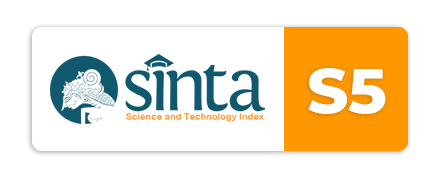ANALISIS PENGARUH VARIASI HASIL PENGELASAN FCAW ANTARA MATERIAL GRADE A TERHADAP MACRO STRUCTURE TEST DI INSERT PLATE SHIP DECK RAMAH LINGKUNGAN
DOI:
https://doi.org/10.33556/jstm.v24i2.418Abstract
Welding has a very important role in engineering and metal production repairs. This is very reasonable because every construction can hardly be separated from metal which involves welding elements. Metal is widely used because it has several advantages, including being strong, rust-resistant, resistant to wear and tear and the raw materials are very economical. The development of technology and science has also had an impact on the increasing demand for metal connections of different types. Several industries that use joining by welding different types of metal include the transportation industry, car manufacturing, shipping and airplanes. One thing that can be done is connecting different types of metal which can be applied in the shipping industry. This research aims to determine the impact of variations in welding FCAW Grade A material 16 mm thick on ship deck insert plates. The use of Flux Core Arc Wellding (FCAW) is often found in the shipping industry. FCAW or what is usually called CO2 arc welding actually includes Metal Inert Gas (MIG) welding, only the protective gas is not only a noble gas such as Argon (Ar) but also CO2 gas or it could be a mixture of the two gases. The FCAW welding process is often used because the protective gas used is CO2 so it is suitable for use in welding steel construction. CO2 decomposes into CO and O2 when in contact with high temperatures. As a result of the high freezing speed, the CO gas produced is trapped in the metal which then forms cavities. Efforts are made to prevent this by providing a mixture of Si and Mn to the electrode so that no gas is trapped and no reaction occurs.References
AWS Welding Handbook. (2004). Welding Processes Part 1 (9th ed., Vol 2).
American Welding Society
Hadi, Eko Sasmiko. 2009. Jurnal: Analisis Pengelasan Mild Steel (ST. 42) dengan Proses SMAW, FCAW dan SAW Ditinjau dari Segi Kekuatan dan Nilai Ekonomis. Teknik Perkapalan: Universitas Diponegoro.
Ichwannuriza, B. (2020). Analisi Pengaruh Gas Pelindung dan Waktu Terpapar Atmospheric Filler E71T1-CiA2- CS1-H4 pada Demand Critical Joint terhadap Kekuatan Tarik dan Ketangguhan. Politeknik Perkapalan Negeri Surabaya.
Latif, Samsul. Analisa Teknis Dan Ekonomis Pembangunan Galangan Kapal Untuk Produksi FPU (Floating Production Unit). 2017. Surabaya: Institut Teknologi Sepuluh Nopember.
Sonawan H., dan Suratman R.2004. Pengantar untuk Memahami Proses Pengelasan Logam,. ALFA BETA, Bandung.
TWI CSWIP 3.1 – Welding Inspector WIS5
Wiryosumarto, H., & Toshie, O. (1996). Teknologi Pengelasan Logam Jakarta: PT. Pradnya Paramita.
Danial dan Warsiah. (2009). Metode Penulisan Karya Ilmiah. Bandung: Laboratorium Pendidikan Kewarganegaraan UPI.
Sugiyono. (2009). Metode Penelitian Kuantitatif Kualitatif dan R&D. Bandung: Penerbit Alfabeta.
Downloads
Published
Issue
Section
License
Authors who publish with this journal agree to the following terms:Authors retain copyright and grant the journal right of first publication with the work simultaneously licensed under a Creative Commons Attribution License that allows others to share the work with an acknowledgement of the work's authorship and initial publication in this journal.
Authors are able to enter into separate, additional contractual arrangements for the non-exclusive distribution of the journal's published version of the work (e.g., post it to an institutional repository or publish it in a book), with an acknowledgement of its initial publication in this journal.
Authors are permitted and encouraged to post their work online (e.g., in institutional repositories or on their website) prior to and during the submission process, as it can lead to productive exchanges, as well as earlier and greater citation of published work (See The Effect of Open Access).




